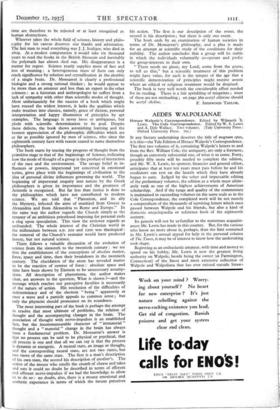AEDES WALPOLIANAE
IF any literary undertaking deserves the title of magnum opus, it is this—the Yale Edition of Horace Walpole's Correspondence. The first two volumes of it, containing Walpole's letters to and from the Rev. William Cole, the antiquary, are only a foretaste, though an extremely substantial one, of what is to come. Forty, possibly fifty more will be needed to complete the edition, and Mr. W. S. Lewis, its sponsor, financier and general editor, anticipates that at least ten years must pass before he and his coadjutors can rest on the laurels which they have already begun to earn. Judged by the sober and impeccable editing of the preliminary volumes, the edition as a whole must ultim- ately rank as one of the highest achievements of American scholarship. And if the range and quality of the commentary is maintained in succeeding volumes on the same scale as in the Cole Correspondence, the completed work will be not merely a compendium of the thousands of surviving letters which once passed between Walpole and his friends, but also a kind of domestic encyclopaedia or reference book of the eighteenth century.
Its genesis will not be unfamiliar to the numerous acquaint- ances Mr. Lewis has made in this country. But, for the curious who know no more about it, perhaps, than the hint contained in Mr. Lewis's annual appeal for help in the personal column of The Times, it may be of interest to know how the undertaking took shape.
Beginning as an enthusiastic amateur, with time and money to spend on his hobby, Mr. Lewis is now the greatest living authority on Walpole, beside being the owner (at Farmington, Connecticut) of the finest and , most extensive collection of Walpole and Walpoliana that has ever existed outside Straw- berry Hill. Few bibliophiles, devoted to a single author and his works, can have been more fortunate than he has been. The stately homes and country houses of England have poured Walpolian relics—books, manuscripts and objets d'art—into his lap. Whole correspondences, long-lost or forgotten, have reappeared at his approach. Half the library at Strawberry Hill has somehow found its way on to his shelves. Even the Gothic lantern, which once lighted Horace Walpole's guests, now hangs, if I am not mistaken, at Farmington, and must, indeed, feel quite at home there. Most collectors, however, of Mr. Lewis's standing and means have neither the inclination nor the capacity to make a fruitful use of their acquisitions, and are content, if they are generously disposed, to let others use them. Mr. Lewis is an exception. He has realised what could be done with his collection and has set about doing it. Not, it, is true, by himself, for the task he had in mind is a formidable one, but in co-operation with a skilled body of supervisors and assistants. Previous editions of Walpole's letters—even Mrs. Toynbee's—were, by the standards he has set himself, imperfect. Their texts were incomplete and inaccurate ; they were poorly annotated, if at all, and they included none of the letters of Walpole's corre- spondents. The purpose of the Yale edition is to remedy these defects.
It is estimated that it will include, when complete, some 7,000 letters. Already 30o unpublished letters of Walpole's have come to light, and to these must be added about 3,000 of his correspondents', two-thirds of which have never been published or only partially printed. The originals of nearly all of them are now at Farmington and will form the basis of Mr. Lewis's accurate and unexpurgated text. For the rest, photographic reproductions have been made. On the recommendation of his advisory committee or privy council of distinguished scholars and other interested parties—a most imposing body—Mr. Lewis has decided to publish the letters by " correspondences " and not chronologically—a procedure that has everything to recommend it. On a far from unanimous judgement (the present reviewer dissenting), Mr. Lewis has decided to modernise his text with the exception of Walpole's punctuation and spelling of proper names. For the time being it is not, I hope, unreasonable to regret that the Yale edition should be represented at its inception by the least interesting of the Walpolian correspondences. Least interesting, that is to say, and often very tedious, unless you happen to be deeply interested in British antiquities and the gout. Walpole needed an antiquary, as it were, on tap, and Cole gushed forth information with all the readiness and bottled-up enthusiasm of a man who lived alone with his folios in the Fens. " You are a mine that answers beyond those of Peru," wrote Walpole, " an oracle in any antique difficulty " I He was indeed, but I fear that only a few specialists will be tempted to read his letters straight through. There are 186 of them, most of which have never been printed before. Yet no serious student of the eighteenth century and, one might add, of the dawning Romantic age, even if he skips the letters themselves, should overlook Dr. Wallace's abundant notes. They are invaluable for reference, and in this connexion a word of praise must be given to Mrs. Moseley for her 83 page index.
I am surprised that only eleven people in this country, apart from H.M. the King, have subscribed to the complete work. In due course, many more people, I hope, will come to recognise its importance. It deserves the encouragement of anyone, interested in the eighteenth century, who can pay the price, and the outlay, taking everything into consideration, is not















































 Previous page
Previous page